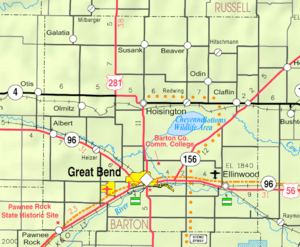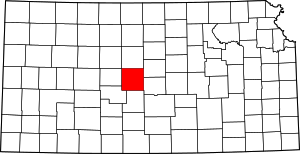Heizer, Kansas
Heizer, also called Heizerton,[2] is an unincorporated community in Barton County, Kansas, United States.[3]
Heizer, Kansas | |
|---|---|
 KDOT map of Barton County (legend) | |
 Heizer  Heizer | |
| Coordinates: 38°25′20″N 98°53′21″W[1] | |
| Country | United States |
| State | Kansas |
| County | Barton |
| Elevation | 1,886 ft (575 m) |
| Time zone | UTC-6 (CST) |
| • Summer (DST) | UTC-5 (CDT) |
| Area code | 620 |
| FIPS code | 20-31275 [1] |
| GNIS ID | 475638 [1] |
History
Heizer was created in the 1880s primarily out of the need for an additional railway stop Northwest of the city of Great Bend, Kansas. The Atchison, Topeka and Santa Fe Railway was in the process of building lines heading out to the Southwest after Colonel Cyrus K. Holliday gained charter to the company in 1859 and gained land grants through Kansas and Texas.[4] The railroad that was built through Great Bend was one such line. The town was named after David N, Heizer, one of the founders of Barton County and the former Mayor or Great Bend who once owned the land that Heizer was built on.[5] For several decades the small frontier settlement boomed with the height of the railroads in Kansas. At one point the town had over 100 residents.[5] It was at this point that most of the businesses were established in the town. However, time passed and life on the Kansas plains grew more difficult, particularly with the onset of the Great Depression in the 1930s and the Dust Bowl, which hit the area particularly hard. People began to leave Kansas in the 20th century just as quickly as they had come in the 19th. Like many towns in the area,[6] Heizer suffered a severe population decrease that continues to this day. Heizer is currently estimated to have approximately 20 residents.
Historical businesses

At its peak, the town of Heizer had numerous places of business [5] that were owned and operated in the town. They included: Train Depot (seen here in its prime), blacksmith, hotel, stockyard, lumberyard, church, school, several grain elevators, general stores, hardware store, Heizer Creamery Co, bank established in 1911. Many of these businesses can be seen in the 1902 map here. None of these businesses are in operation today. Only a few of the original buildings still exist, and most are condemned.
Walnut Creek Bridge
In 1887, Barton County opened contract bids for four iron bridges within the county. The Walnut Creek Bridge, to be constructed 0.5 mi. North and 0.5 mi. West of Heizer,[7] was given to C.R. Lane of Topeka, Kansas. Lane was the manager of Topeka's office of the Lane Bridge and Iron Works, a company which provided a variety of metalworking services throughout the Midwest. The company was given $3,700 for the contract, which is equivalent to about $92,204.69 today.[8] The Walnut Creek Bridge "is a pin connected Pratt through truss" which spans 115' long and 16' wide with a wood deck 21' above Walnut Creek.[9] The bridge is unique due to the fact that it is constructed of wrought-iron, which is no longer used in bridge construction with steel being preferable. Additionally, of all Pratt through truss bridges, the Walnut Creek Bridge is the only one known to be constructed by P.E. Lane, who worked for the Lane Bridge and Iron Works company. The bridge was completed in 1887, meaning that horses and wagons were the first vehicles to use the bridge, although eventually it carried cars.[10]
Although the bridge was officially listed in the National Register of Historic Places in 1990, marking it as a structure of historical importance,[9] it was not enough to save the bridge from falling into disrepair. Today the bridge has been abandoned and its main wooden deck has been removed, as well as the structure as a whole being deemed structurally deficient and likely for imminent failure.[7] Photos of the bridge when it was still in use can be seen here and the bridge can also be seen from satellite here.
Notable people
- Jacob Halman patented a new type of plow point in 1903.[11]
- Fred Garrett along with Charles Wilkins of Hutchinson, Kansas patented a new design for disk bearings for use in cultivators in 1903.[12]
- Frank Trauer patented his improvements in locomotive feed-water heaters for steam boilers in 1903.[13]
References
- Geographic Names Information System (GNIS) details for Heizer, Kansas; United States Geological Survey (USGS); October 13, 1978.
- Baughman, Robert W. Kansas Post Offices, 1828-1961, Wichita: McCormick-Armstrong Company, 1961. Lists post offices with dates and counties, cross referenced with former names. https://geonames.usgs.gov/apex/f?p=138:4:0::NO:4:P4_FID,P4_OBJECTID,P4_FNAME:475638,31641265,Heizerton
- U.S. Geological Survey Geographic Names Information System: Heizer, Kansas
- Dye, Victoria. All Aboard for Santa Fe : Railway Promotion of the Southwest, 1890s to 1930s, University of New Mexico Press, 2007.
- Biographical History of Barton County, Kansas. Great Bend Tribune, 1912. Print. pgs 78, 79. https://books.google.com/books?id=hnYUAAAAYAAJ
- http://www.ipsr.ku.edu/ksdata/ksah/population/2pop33.pdf
- http://bridgehunter.com/ks/barton/50651505163
- http://www.in2013dollars.com/1887-dollars-in-2017?amount=3700
- http://www.kshs.org/resource/national_register/nominationsNRDB/KS_BartonCounty_MetalTrussBridgesMPS_walnutcreekbridgeNR.pdf
- Bickel, Amy. Bridge Spans a Lost Age in Engineering. Hutchinson News, The (KS), 2010.
- Halman, Jacob. “Plow-Point.” 18 Aug. 1903. http://www.google.com/patents/US736845
- Wilkins, Charles F., and Fred A. Garrett. “Bearing for Disks.” 29 Sept. 1903. http://www.google.com/patents/US740345
- Trauer, Frank C. “Feed-Water Heater.” 31 Mar. 1903. http://www.google.com/patents/US724413
